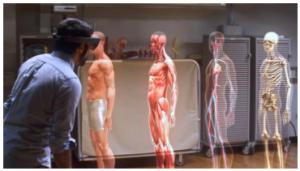Source: https://www.youtube.com/watch?v=vslhErzDKJ4
A hologram is a 3‐D representation of a subject projected onto a display medium. A hologram is not
formed by a lens and therefore is not an image. Most modern holograms utilize laser light for creating
the subject. The process is very complicated and requires a reader to scan the subject of interest, a
processor to translate the subject into a digital message, and finally a laser apparatus to create the final
hologram. In the medical world, modern imaging devices such as CT scanners and MRI can assist in
creating the subject images. There are also options to create or design a subject using computer
software. By definition a true hologram once created can be viewed without the need of special optics,
but intermediate optics can create a hologram for the intent of this topic.
Print Friendly
The current status of holograms in medicine remains an experimental field. The most obvious use is for
medical training to assist in teaching. The ability to visualize life size true 3‐D representations of organs,
and body systems would be invaluable. Holograms could one day replace cadavers in medical school
anatomy courses. They could be used for surgical demonstrations, comparative anatomy, and testing
purposes. Adding animation would further strengthen the advantages on creating true representations
of physiology along with the relevant anatomy.
Current medical applications of holography are approaching widespread use. Converting MRIs, CT scans,
ultrasounds and other imaging modalities into 3D reconstructions already exist. Although 3D
representations manipulated on a 2D viewing screen is not a hologram, translating that technology to a
true hologram is available from a number of proprietary companies for experimental use. As the
technology advances, more applications will become available and have clinical utility beyond
imagination.
Non‐medical applications of holograms are infinite in scope. They are already utilized in military
mapping, data storage, security encryption, and modern art. As the technology becomes more
affordable and more practical, expansion into all aspects of projection will come to be.




